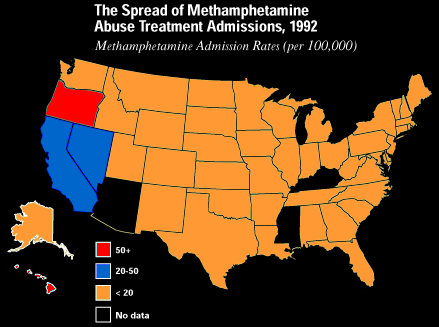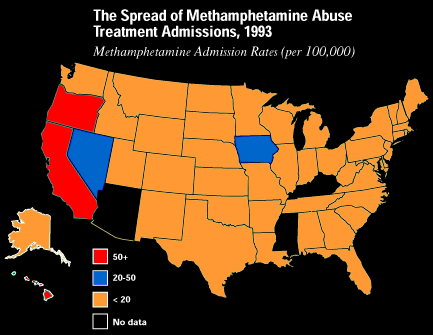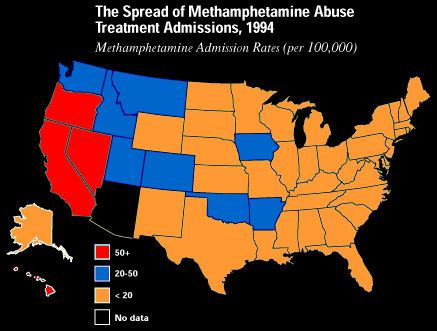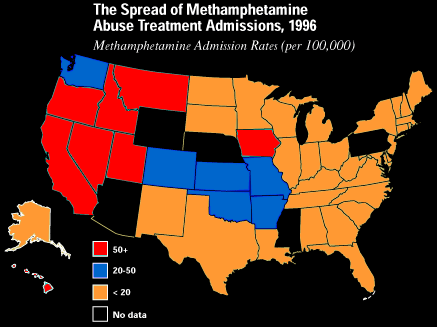Meth Addiction

History of Meth
Early methamphetamine
First synthesized in 1887 Germany, amphetamine was for a long time, a drug in search of a disease. Nothing was done with the drug, from its discovery (synthesis) until the late 1920's, when it was seriously investigated as a cure or treatement against nearly everything from depression to decongestion.
In the 1930's, amphetamine was marketed as Benzedrine in an over-the-counter inhaler to treat nasal congestion (for asthmatics, hay fever sufferers, and people with colds). A probable direct reaction to the Depression and Prohibition, the drug was used and abused by non-asthmatics looking for a buzz. By 1937 amphetamine was available by prescription in tablet form.
Methamphetamine, more potent and easy to make, was discovered in Japan in 1919. The crystalline powder was soluble in water, making it a perfect candidate for injection. It is still legally produced in the U.S., sold under the trade name Desoxyn.
During World War II, amphetamines were widely used to keep the fighting men going (during the Viet Nam war, American soldiers used more amphetamines than the rest of the world did during WWII). In Japan, intravenous methamphetamine abuse reached epidemic proportions immediately after World War II, when supplies stored for military use became available to the public.
In the United States in the 1950s, legally manufactured tablets of both dextroamphetamine (Dexedrine) and methamphetamine (Methedrine) became readily available and were used non medically by college students, truck drivers, and athletes, As use of amphetamines spread, so did their abuse. Amphetamines became a cure-all for such things as weight control to treating mild depression.
This pattern changed drastically in the 1960s with the increased availability of injectable methamphetamine. The 1970 Controlled Substances Act severely restricted the legal production of injectable methamphetamine, causing its use to decrease greatly.
Methamphetamine trafficking and abuse in the United States have been on the rise over the past few years, as indicated by investigative, seizure, price, purity, and abuse data (see "trends" below). As a result, this drug is having a devastating impact in many communities across the nation. Although more common in western areas of the country, this impact increasingly is being felt in areas not previously familiar with the harmful effects of this powerful stimulant.
Clandestine production accounts for almost all of the methamphetamine trafficked and abused in the United States. The illicit manufacture of methamphetamine can be accomplished in a variety of ways, but is produced most commonly using the ephedrine/pseudoephedrine reduction method. Large-scale production of methamphetamine using this method is dependent on ready access to bulk quantities of ephedrine and pseudoephedrine. During the past two years, several bulk ephedrine seizures destined for Mexico focused attention on the magnitude of ephedrine acquisition by organized crime drug groups operating from Mexico and in the United States, and set in motion an effort to focus international attention on the ephedrine diversion problem and to take action to prevent such diversion.
Drug law enforcement efforts against clandestine methamphetamine producers constitute a "cat and mouse" game between efforts to cut off chemical supplies and efforts to obtain them from non-regulated sources. Past experience has demonstrated that methamphetamine traffickers are relentless, flexible, and creative in finding new ways to obtain chemicals by evading the network of international controls that has been established. The Federal Government currently is preparing regulations to further reduce the diversion of pharmaceutical products containing chemicals, such as ephedrine and pseudoephedrine, that can be used to produce illegal drugs. It has consulted with corporations within the pharmaceutical industry to develop a solution to the diversion problem that does not unduly restrict the availability of these chemicals for legitimate use.
Domestically, large-scale production of methamphetamine is centered in California. In addition, methamphetamine increasingly is produced in Mexico and smuggled into the United States. Methamphetamine laboratory operators often are well-armed, and their laboratories occasionally are booby-trapped and equipped with scanning devices employed as security precautions. Weaponry, ranging from single firearms to arsenals of high-powered weapons and explosives, are commonly found at laboratory sites. Not only are methamphetamine laboratories used to manufacture illegal, often deadly drugs, but the clandestine nature of the manufacturing process and the presence of ignitable, corrosive, reactive, and toxic chemicals at the sites have resulted in explosions, fires, toxic fumes, and irreparable damage to human health and to the environment.
Traditionally, the suppliers of methamphetamine throughout the United States have been outlaw motorcycle gangs and numerous other independent trafficking groups. Although these groups continue to produce and distribute methamphetamine, organized crime drug groups operating from Mexico currently dominate wholesale methamphetamine trafficking in the United States for several reasons: these organizations established access to wholesale ephedrine sources of supply on the international market; these organizations are producing unprecedented quantities of high-purity methamphetamine on a regular basis; and, they already control well-established cocaine, heroin, and marijuana distribution networks throughout the western United States, enabling them to supply methamphetamine to a large retail level market. Their expansion into the methamphetamine trade has added a new dimension to their role in the U.S. drug market and has redefined the methamphetamine problem in the United States. Presently, these organizations are poised to supply methamphetamine to the rest of the country in response to any increases in demand.
Trends in methamphetamine use
As we begin 1997, the West, Southwest, and the South there are reports of methamphetamine and ephedrine as emerging drugs. According to DEA sources, Mexican manufacturers and distributors have replaced the outlaw motorcycle groups which had produced methamphetamine supplies for over twenty years. The new manufacturers are producing large quantities of high purity methamphetamine on both sides of the border, drawing on the legal supply of the precursor chemicals on the Mexican side. The price of methamphetamine had dropped significantly (to approximately $3000/pound in Southern California) until recent efforts to curtail ephedrine/pseudoephedrine supplies produced a slight shortage in some areas and a corresponding price increase. In Washington State, sources report that the resultant price increase has caused a number of methamphetamine users in that area to switch to cocaine.
One Texas source cited a number of reports of adverse effects of ephedrine and pseudoephedrine, a common substance in a number of over the counter and/or health food products. Ephedrine tablets can be purchased in Mexico and are often seized at the border or in other locations in transit to U.S.-based manufacturers. Some of the ephedrine/pseudoephedrine products readily available in Texas include 40 or 50 milligrams of ephedrine as well as substantial quantities of caffeine. Adverse consequences of their use include agitation, palpitations, and fainting from the stimulant effect. Called "herbal ecstasy" in both Texas and Southern California and touted as "safe" or "legal" MDMA, it is reportedly available from some health food stores or through mail order.
Methamphetamine continues to be popular in San Francisco. The ethnographer from that area reports that in addition to its use by young users who combine it with heroin ("a meth speedball") it can also be found in "biker's coffee," a combination of methamphetamine and coffee popular among young, fairly affluent urbanites. This is similar to the population of users described by the Los Angeles source. In that area, users are primarily snorting methamphetamine rather than smoking it as "ice" or injecting it.
Methamphetamine: A Dangerous Drug, A Spreading Threat
Methamphetamine is a highly addictive drug that can be manufactured by using products commercially available anywhere in the United States. The chemicals used in producing methamphetamine are extremely volatile, and the amateur chemists running makeshift laboratories -- often in hotels or areas where children are present -- cause deadly explosions and fires. The by-products of methamphetamine production are extremely toxic. Methamphetamine traffickers display no concern about environmental hazards when it comes to manufacturing and disposing of methamphetamine and its by-products.

The effects of methamphetamine on humans are profound. SAMHSA is currently testing the effectiveness of various treatment regimens for methamphetamine, an addiction that is extremely difficult to treat. The stimulant effects from methamphetamine can last for hours, instead of minutes as with crack cocaine. Often the methamphetamine user remains awake for days. As the high begins to wear off, the methamphetamine user enters a stage called "tweaking," in which he or she is prone to violence, delusions, and paranoia. Many methamphetamine users try to alleviate the effect of the methamphetamine "crash" by buffering the effects with other drugs such as cocaine or heroin. Like heroin and cocaine, methamphetamine can be snorted,smoked, or injected.

Overall usage. The 1997 NHSDA estimated that 5.3 million Americans (2.5 percent of the population) have tried methamphetamine in their lifetime, up significantly from the 1994 estimate of 1.8 million. The ADAM system reports that methamphetamine use continues to be more common in the western United States than in the rest of the nation. Methamphetamine use, according to ADAM, increased substantially in 1997, negating the progress achieved in 1996. In San Diego, roughly 40 percent of both male and female arrestees tested positive for methamphetamine.

Use among youth. The 1998 MTF survey asked 12th graders about the use of crystal methamphetamine known as "ice" -- which is smoked or burned in rock form. The survey found that lifetime ice use -- which had leveled-off at 4.4 percent in 1997 after a four-year rise -- rose in 1998 to 5.7 percent. The perceived harmfulness of methamphetamine among youth has also declined steadily since 1992 -- when 61.9 percent of 12th graders perceived "great risk" in trying "ice" once or twice -- to 1998, when only 52.7 percent perceived great risk.

Availability. Methamphetamine is by far the most prevalent synthetic controlled substance clandestinely manufactured in the United States. In the West and Southwest, it is increasingly significant as a drug of abuse: 52 percent of all those arrested in San Jose for drug possession, for example, test positive for methamphetamine. The Midwest has also seen an increase in methamphetamine production, trafficking and consequences. While the drug is not commonly found in the East and Southeast an analysis of methamphetamine treatment admissions as well as increased seizures suggest that the use of the drug maybe spreading eastward. The number of methamphetamine laboratory seizures reported to the Drug Enforcement Administration (DEA) in 1997 increased dramatically, to 1,431 from 879 in 1996. This reflects the widespread proliferation in the manufacture, trafficking, and use of the drug across the West and Midwest and portions of the South. During 1997 methamphetamine prices nationwide ranged from $3,500 to $30,000 per pound, $400 to $2,800 per ounce, and 37 dollars to $200 per gram.

Source: SAMHSA, OAS, TEDS (Jan 1998)
